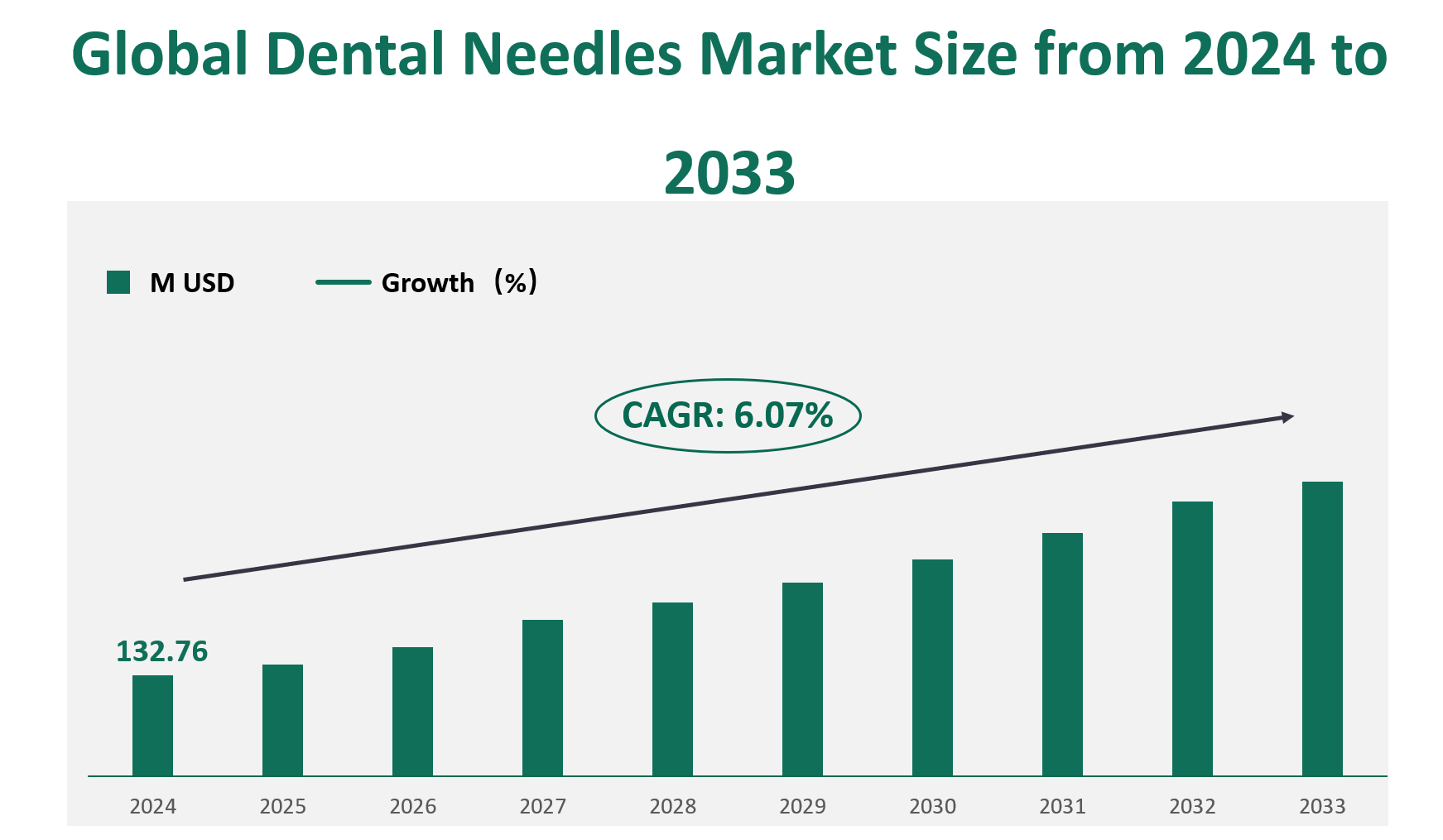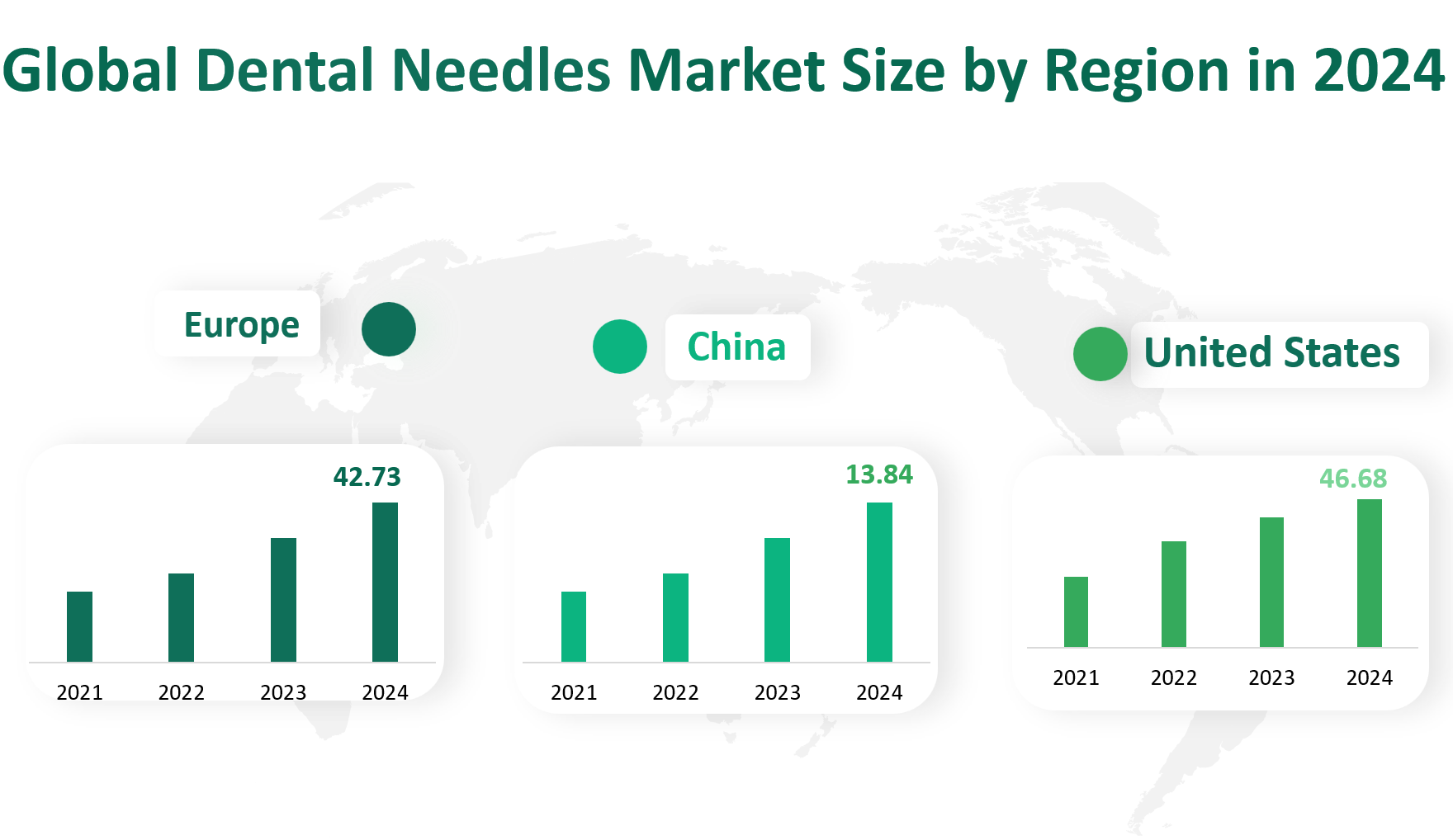1. Global Dental Needles Market Insight Analysis
Dental needles are essential tools used in dentistry to administer local anesthetics, ensuring patients experience minimal discomfort during dental procedures. These needles are designed with precision to minimize tissue trauma and ensure smooth injections. They are typically made from high-grade stainless steel and come in various sizes and gauges to accommodate different dental procedures. The needles are sterilized and often feature a triple-bevel design to reduce insertion pain and improve procedural efficiency.
In 2024, the global dental needles market is projected to reach a revenue of approximately $132.76 million, with a Compound Annual Growth Rate (CAGR) of 6.07% from 2024 to 2033.
Figure Global Dental Needles Market Size (M USD) and CAGR (2024-2033)

2. Driving and Limiting Factors of Dental Needles Market Growth
The global rise in dental health awareness has led to an increased demand for dental procedures, including fillings, extractions, and cosmetic dentistry. This has directly contributed to the higher consumption of dental needles.
The growing geriatric population, which is more susceptible to dental issues, has significantly driven the demand for dental needles. According to the World Health Organization, the global geriatric population is expected to double by 2050, reaching 2.1 billion. This demographic shift is a major driver for the market.
Innovations in dental needle design and manufacturing have led to the development of safer and more effective needles. These advancements not only improve patient comfort but also enhance procedural outcomes, making dental needles more essential in modern dentistry.
Governments around the world are increasingly focusing on public oral health initiatives, which include the provision of dental care services. These programs often require a significant supply of needles, thereby boosting market demand.
Rising disposable incomes in emerging economies have led to increased spending on healthcare, including dental care. This has created a larger market for dental needle, particularly in regions like Asia-Pacific.
Despite the positive growth trajectory, the dental needle market faces several challenges: Intense competition among manufacturers has led to price wars, which can reduce profit margins. This competition is particularly evident in regions with high market saturation. The dental needle industry is subject to stringent regulatory requirements to ensure product safety and efficacy. Compliance with these regulations can be costly and time-consuming for manufacturers.
Rising labor costs in developed countries, where many dental needle manufacturers are based, have increased production costs. This can impact the overall profitability of the industry.
Global economic downturns can lead to reduced spending on healthcare, including dental care. This can negatively impact the demand for dental needle.
3. Technological Innovation and Corporate Mergers and Acquisitions in the Dental Needles Market
Technological innovation has been a cornerstone of the dental needle market, with manufacturers continuously seeking to improve product performance and safety. Recent advancements include the development of needles with enhanced flexibility, reduced pain, and improved accuracy. These innovations are crucial for meeting the evolving needs of dental professionals and patients.
Corporate mergers and acquisitions have also played a significant role in shaping the dental needle market. Major players such as Septodont, Dentsply Sirona, and Kulzer have engaged in strategic acquisitions to expand their product portfolios and strengthen their market positions. For instance, Septodont’s acquisition of an injectable dental anesthetic manufacturing plant from Dentsply International in 2016 has enhanced its capabilities in this segment. Similarly, Dentsply Sirona’s acquisition of Byte®, a leading clear aligner company, has expanded its presence in the orthodontic market.
4. Global Dental Needles Market Size by Type
Dental needles are essential tools used in dental procedures to administer local anesthesia. These needles are designed to minimize patient discomfort and ensure smooth injections. The market for dental needles can be segmented into two primary types: With Bevel Indicator and Without Bevel Indicator.
With Bevel Indicator: These needles feature an indicator dot on the hub, which helps dentists easily identify the bevel position. This design reduces the risk of needlestick injuries and ensures more accurate and consistent injections. The bevel indicator is particularly useful in minimizing patient discomfort by allowing for a more precise angle of insertion.
Without Bevel Indicator: These needles lack the bevel indicator dot. They are generally less expensive than their counterparts with bevel indicators but may require more skill from the dentist to ensure proper insertion.
In terms of market revenue, the With Bevel Indicator type holds a significantly larger market share. In 2024, the market revenue for dental needles With Bevel Indicator is projected to be USD 123.39 million, while the revenue for needles Without Bevel Indicator is estimated at USD 9.37 million. This indicates that the With Bevel Indicator type dominates the market, capturing approximately 92.94% of the total market revenue in 2024F.
Table Global Dental Needles Market Size by Type in 2024
Market Size (M USD) 2024 | Market Share | |
With Bevel Indicator | 123.39 | 92.94% |
Without Bevel Indicator | 9.37 | 7.06% |
5. Global Dental Needles Market Size by Application
The dental needles market can also be segmented based on its applications, which primarily include Hospitals, Clinics, and Other applications such as dental schools and specialized dental centers.
Dental needles are extensively used in general hospitals with dentistry departments and specialized dental hospitals. These institutions perform a wide range of dental procedures, from routine check-ups to complex surgeries, necessitating the use of high-quality dental needles. In 2024, the market revenue for dental needles used in hospitals is projected to be USD 80.43 million.
Dental clinics are another major application area for dental needles. These clinics, which can be found in various settings such as schools, government offices, and private practices, cater to a large number of patients requiring routine dental care. The market revenue for dental needles used in clinics in 2024 is estimated at USD 40.20 million.
Table Global Dental Needles Market Size by Application in 2024
Application | Market Size (M USD) 2024 | Market Share |
Hospitals | 80.43 | 60.59% |
Clinics | 40.20 | 30.28% |
Others | 12.13 | 9.14% |
6. Global Dental Needles Market Size by Region
The United States is the largest regional market by revenue, accounting for 35 % of the global dental needles market in 2024. This dominance is attributed to several factors, including a strong medical infrastructure, a well-established reimbursement policy for dental procedures, and a significant geriatric population that requires extensive dental care. The presence of key market players and advanced preventive and restorative dental treatments further bolster the market in this region.
Europe is the second-largest regional market, with a revenue share of 33% in 2024. The region benefits from a high level of healthcare spending, advanced medical technology, and a growing awareness of oral health. Key markets within Europe include Germany, the UK, France, Italy, and Spain, each contributing significantly to the overall market revenue.
China is emerging as a significant player in the dental needles market, with a revenue share of 9.5% in 2020. The rapid economic growth, increasing healthcare expenditure, and a large population base drive the demand for dental needles in this region. China’s focus on R&D and medical tourism further enhance its market position.
Japan holds a revenue share of 9 % in 2020. The country’s advanced medical technology, high healthcare standards, and an aging population contribute to its substantial market share. Japan’s dental needles market is characterized by high-quality products and a strong emphasis on innovation.
Figure Global Dental Needles Market Size by Region in 2024

7. Global Dental Needles Market Analysis by Major Players
7.1 Septodont
Introduction and Business Overview: Septodont, founded in 1932 and headquartered in France, is a leading global manufacturer of dental products. The company specializes in endodontics, impression materials, infection control, pain control, periodontology, and surgical products. Septodont’s commitment to innovation and quality has established it as a trusted name in the dental industry.
Products: Septodont offers a wide range of dental needles, including Septoject®, which features a triple-bevel needle design for reduced tissue trauma and enhanced flexibility. The company’s needles are available in various sizes and gauges to meet different clinical needs.
7.2 Dentsply Sirona
Introduction and Business Overview: Dentsply Sirona, headquartered in the United States, is a major player in the dental equipment and consumables market. The company offers a comprehensive range of dental products and solutions, catering to dental professionals worldwide. Dentsply Sirona’s extensive product portfolio and strong market presence make it a key competitor in the dental needles market.
Products: Dentsply Sirona’s dental needles, such as Accuject, feature a red dot bevel indicator for easy identification and reduced risk of needlesticks. The company’s needles are designed for accurate and consistent injections, ensuring patient safety and comfort.
7.3 Kulzer
Introduction and Business Overview: Kulzer, headquartered in Germany, is a leading dental company known for its innovative and high-quality products. As part of the Mitsui Chemicals Group, Kulzer offers a wide range of dental solutions, including dental needles, impression materials, and restorative products. The company’s commitment to innovation and quality has earned it a strong reputation in the dental industry.
Products: Kulzer’s dental needles, such as SeleKt+, are designed with a triple-bevel tip for minimal tissue trauma and enhanced patient comfort. The company’s needles also feature a unique short bevel design, making them ideal for intraligamentary anesthesia.

